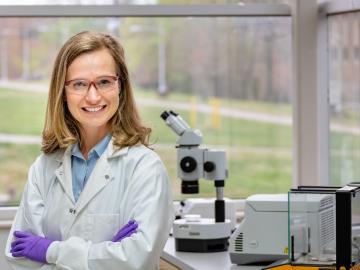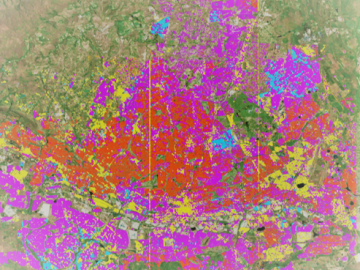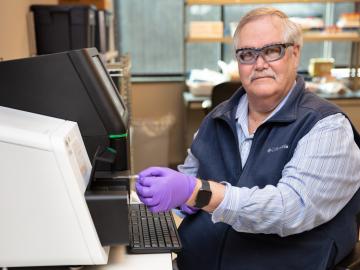
Filter News
Area of Research
- (-) Biological Systems (18)
- (-) Biology and Environment (177)
- (-) National Security (79)
- (-) Nuclear Science and Technology (74)
- Advanced Manufacturing (34)
- Biology and Soft Matter (5)
- Building Technologies (12)
- Chemical and Engineering Materials (4)
- Chemistry and Physics at Interfaces (11)
- Clean Energy (522)
- Climate and Environmental Systems (14)
- Computational Biology (6)
- Computational Chemistry (5)
- Computational Engineering (5)
- Computer Science (19)
- Data (1)
- Earth Sciences (1)
- Electricity and Smart Grid (3)
- Energy Frontier Research Centers (14)
- Energy Sciences (5)
- Fossil Energy (3)
- Fuel Cycle Science and Technology (3)
- Functional Materials for Energy (16)
- Fusion and Fission (54)
- Fusion Energy (17)
- Geographic Information Science and Technology (3)
- Isotope Development and Production (3)
- Isotopes (35)
- Materials (433)
- Materials Characterization (2)
- Materials for Computing (36)
- Materials Synthesis from Atoms to Systems (13)
- Materials Under Extremes (12)
- Mathematics (1)
- Neutron Data Analysis and Visualization (4)
- Neutron Science (190)
- Nuclear Systems Modeling, Simulation and Validation (3)
- Nuclear Systems Technology (1)
- Quantum Condensed Matter (4)
- Quantum information Science (9)
- Reactor Technology (1)
- Renewable Energy (4)
- Sensors and Controls (5)
- Supercomputing (311)
- Transportation Systems (11)
News Type
News Topics
- 3-D Printing/Advanced Manufacturing (17)
- Advanced Reactors (13)
- Artificial Intelligence (21)
- Big Data (15)
- Bioenergy (49)
- Biology (74)
- Biomedical (20)
- Biotechnology (13)
- Buildings (3)
- Chemical Sciences (12)
- Clean Water (11)
- Climate Change (43)
- Composites (5)
- Computer Science (38)
- Coronavirus (16)
- Critical Materials (1)
- Cybersecurity (19)
- Decarbonization (21)
- Energy Storage (8)
- Environment (92)
- Exascale Computing (5)
- Frontier (4)
- Fusion (10)
- Grid (9)
- High-Performance Computing (24)
- Hydropower (8)
- Isotopes (7)
- Machine Learning (19)
- Materials (13)
- Materials Science (12)
- Mathematics (3)
- Mercury (7)
- Microscopy (10)
- Molten Salt (5)
- Nanotechnology (8)
- National Security (35)
- Net Zero (2)
- Neutron Science (12)
- Nuclear Energy (41)
- Partnerships (8)
- Physics (5)
- Polymers (2)
- Quantum Science (1)
- Renewable Energy (1)
- Security (12)
- Simulation (14)
- Space Exploration (5)
- Summit (12)
- Sustainable Energy (33)
- Transformational Challenge Reactor (4)
- Transportation (5)
Media Contacts
A team of scientists led by Oak Ridge National Laboratory have discovered the specific gene that controls an important symbiotic relationship between plants and soil fungi, and successfully facilitated the symbiosis in a plant that

Researchers have developed high-fidelity modeling capabilities for predicting radiation interactions outside of the reactor core—a tool that could help keep nuclear reactors running longer.

For the first time, Oak Ridge National Laboratory has completed testing of nuclear fuels using MiniFuel, an irradiation vehicle that allows for rapid experimentation.

Amber McBride is using her expertise in nanotechnology, drug delivery, and disease models to research fundamental challenges in human health in the ORNL Biosciences Division.

Scientists have demonstrated a new bio-inspired material for an eco-friendly and cost-effective approach to recovering uranium from seawater.

Oak Ridge National Laboratory scientists are evaluating paths for licensing remotely operated microreactors, which could provide clean energy sources to hard-to-reach communities, such as isolated areas in Alaska.

Scientists at the Department of Energy’s Oak Ridge National Laboratory are working to understand both the complex nature of uranium and the various oxide forms it can take during processing steps that might occur throughout the nuclear fuel cycle.

Oak Ridge National Laboratory is using ultrasonic additive manufacturing to embed highly accurate fiber optic sensors in heat- and radiation-resistant materials, allowing for real-time monitoring that could lead to greater insights and safer reactors.

Geospatial scientists at Oak Ridge National Laboratory analyzed three cities of varying infrastructures to look for patterns of electricity use and locate “dark spots” where informal neighborhoods may lack access to power.



